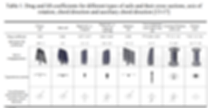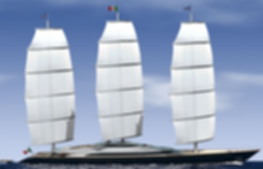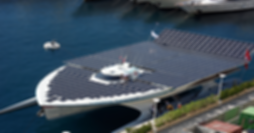RENEWABLE ENERGY TECHNOLOGY IN INDUSTRIAL SHIPPING INDUSTRY
The introduction of new regulations has encouraged ship designers to pursue other renewable energy technologies to assist in reducing the use of fuel in the shipping industry. Marine renewable energy resources are one of the attractive options, sources such as wind and solar power are in abundance in open water. These renewable technologies can be separated into two main categories.
Wind Assisted Propulsion
Wing Sails
Wing Sails technology is aerodynamically identical to an aircraft wing (Milić Kralj and Klarin, 2016). There are several types of wing sail technology that are currently used in the industry as ships with rigid wing sails have advantageous features offering increased efficiency, smooth operation, security, and more advanced control systems.
However, this technology has a major disadvantage in that due to its rigidity and hardness the sail will have large mass and inertia. In addition to this, wing sails are not completely reef-able or stow-able unlike traditional sails (Milić Kralj and Klarin, 2016). Therefore, when a ship is stationary, or in high winds, the ships integrity may be at risk.
The case study by Kralj and Klarin, demonstrates the different drag and lift coefficients present in multiple types of sails as per the following figure. Based on this, it can be seen that the Turbosail and Flettner rotor have the highest lift coefficient values.
The outcome from the evaluation is as per the table below. Based on the table, it demonstrated that classic sails applied on boats for sport purposes and leisure has the highest overall value in terms of useful parameters. However, in terms of industrial shipping, the Flettner rotor is the optimum sail type as it has greater efficiency and profitability than the Turbosail. Profitability in this context refers to direct saving of fossil fuels and profits from the sale of its CO2 tariffs (Milić Kralj and Klarin, 2016).
Flettner Rotor
Based on the case study by Traut et al (2014), one of the main advantages of using the Flettner rotor is that the technology is able to harness a wide spectrum of wind directions and the transient power contribution is similar in either direction. However, this technology requires significant deck space compared to the towing kite technologies and the rotor height and weight will impact the hydrodynamic behaviour and hence overall design of the ship. This will also contribute to the installation cost of the rotor. Nevertheless, in comparison to other wind assisted propulsion technologies, the Flettner Rotor is significantly more advanced and has proven to reduce the overall fuel consumption of a ship which leads to a reduction in operating costs and greenhouse gas emissions.
Turbo-sails
Turbo-sail technology uses a fixed cylinder that looked like a smokestack and functions like an aeroplane wing. The ovoid-section cylinder acts exactly like a sail and there is a huge fan located in the cylinder that sucks air flow through a permeable wall creating a lift force (Fournier, et al., 2019).
This technology was installed on a ship named, Alycyone. It was concluded that the propulsion power generated from the system did not compensate for the cost of the system installation. In addition to this, due to the requirement of a large area on the deck, a high capital requirement and low efficiencies this technologies was not further developed (Patricia, 2015).
Towing Kite
Towing kite technology operates using a large foil kite and electronic control system. The main advantage in the use of a towing kite is that the kite can operate at higher altitudes enabling the capture of greater wind speeds. In addition to this, the kite requires less deck space and does not require a change in the main dimensions of the ship as it will not impact the overall ship weight limitation (Traut et al, 2014). Furthermore, due to the minimal installation requirements, this technology can be easily installed at a lower price.
However, the performance of the kite is sensitive to wind conditions as the technology is highly dependent on the relative wind speed with respect to the ship speed. In a case study by Traut et al (2014), the kite was unable to deliver any propulsive power for the first half of the outgoing journey and for the full return journey.
Dyna Rigs (modern square rig)
Dyna Rigs technology is a combined rig and hull with high efficiency using wind to propel a large vessel across an open body of water. However, in the case of industrial shipping, Dyna rigs take a significant amount of deck space and so it is not a suitable technology. This technology is mainly used on mega yachts.
(Yachtforums.com, 2019)
Other Renewable Energy Technologies
Solar Power
Solar power could be utilised as an auxiliary power source by installing solar panels on the deck of a vessel. The electricity generated would be used to drive the electrical engine. This technology was tested on M/V Auriga Leader and it was concluded that after seven months, the panel has produced 0.5% of the propulsion and 1 % of the electricity requirements (Kindberg, 2015). This technology generated minimal reductions in relation to the amount of the required power and the system produced unstable power supply as the slightest changes in the weather can have a large effect on the power output.
In 2012, the largest 100% solar powered vessel, the Turanor Planet Solar was designed by an international team and built in Kiel, Germany. The boat installed 5,300 sq. ft. of solar panels and can operate for three days using stored energy (Tidewatercurrent.com, 2019).
Source: Tidewatercurrent.com, 2019
Hybrid Vessel
A hybrid propulsion power concept cruise ship (Eoseas) has been developed by STX Europe (Ship Technology, 2019). Eoseas will be powered by four dual-fuel LNG diesel electric generator sets, an advanced heat recovery plant, 8,300m² photovoltaic panels and an organic waste gasification plant on-board. In addition to this, the plan is to equip the ship with an innovative sail concept (five masts over 12,440m²) in order use wind energy for propulsion.
The target for the cruise vessel is to reduce consumption of power by half. (Marine Insight, 2019). As this is still a concept ship there is no proof that this ship will be economically for the industrial shipping sector.
Hydrogen ship
A hydrogen ship is power assisted by an electric motor that is powered by a hydrogen fuel cell. There are several small ships using fuel cells to power the electrical motor onboard. However, the main issue with this technology is the storage of hydrogen on ships. There have been studies based on onboard hydrogen generation, however, this technology is still premature with most concepts at an early design or trial phase (Hydrogeneurope.eu, 2019). There have been continuous studies on the viability of this technology with synergies between hydrogen, wind and solar. If the technology were to be developed further, it would provide great potential for use in the shipping industry as a hybrid ship.
References
Atkins Research Development & Great Britain. Ship Marine Technology Requirements Board, 1980. AWASH program for the analysis of wind assisted ships, Epsom: Atkins Research and Development.
Clauss SH, G GF, Tampier B. Simulation of the operation of wind-assisted cargo ships. In: Hauptversammlung der Schiffbautechnischen Gesellshaft, Berlin; 21–23 November 2007. PDF available from: [accessed Apr 03 2019].
Cousteau.org. (2019). Turbosail. [online] Available at: [Accessed 4 March 2019].
Ec.europa.eu. (2019). [online] Available at: [Accessed 14 Feb. 2019].
Ellycia Harrould-Kolieb (2008). Shipping Impacts On Climate: A Source With Solutions. www.oceana.org
Fournier, G., Pellerin, S. and Ta Phuoc, L. (2019). Control of an Incompressible Turbulent Flow Past a Circular Cylinder Computed by Large Eddy Simulation.
Imo.org. (2019). Energy Efficiency Measures. [online] Available at: [Accessed 24 March. 2019].
Izaguirre-Alza, Patricia. Numerical And Experimental Studies Of Sail Aerodynamics. 1st ed. Madrid: Technical university of Madrid, 2012. Web. Accessed on: 6th March 2019. Available at: http://oa.upm.es/14885/1/PATRICIA_IZAGUIRRE_ALZA_A.pdf
Marine Insight. (2019). Eoseas: A 5 Hulled Cruise Ship Concept. [online] Available at: [Accessed 4 Apr. 2019].
Milić Kralj, D. and Klarin, B. (2016). Wing Sails for Hybrid Propulsion of a Ship. Journal of Sustainable Development of Energy, Water and Environment Systems, 4(1), pp.1-13.
P. Kindberg, Wind-powered auxiliary propulsion in cargo ships, August 2015.
Ship Technology. (2019). Eoseas Concept Cruise Ship - Ship Technology. [online] Available at: [Accessed 20 March 2019].
Tidewatercurrent.com. (2019). Sailing into a Sustainable Future - Sustainable Port and Shipping Initiatives | Solar Touring | Bay "smart buoys" give real-time weather info | Wind to Power Beach Manufacturing Plant | DuCard Winery - Virginia's Solar Factory | UM purchases underwater drone for coastal studies | Alternative Fueling Station Locator & Vehicle Guide. [online] Available at: [Accessed 4 Apr. 2019].
Traut, M., Gilbert, P., Walsh, C., Bows, A., Filippone, A., Stansby, P. and Wood, R. (2014). Propulsive power contribution of a kite and a Flettner rotor on selected shipping routes. Applied Energy, 113, pp.362-372.
Yachtforums.com. (2019). New Design: Perini Navi 335' Dyna-Rig - Perini Navi News & Launches | YachtForums: We Know Big Boats!. [online] Available at: [Accessed 4 Apr. 2019].



